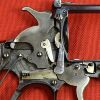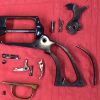Driftwood, we had this discussion the other year. Is it now the thinking that hardened cosmoline prevented the rebound slide from moving fully forward, and thus not supporting the hammer in its rebound position? The later, hammer blocking safety is powered by the pin on the rebound slide...if that slide is sticking, the hammer block
still wouldn't be in position to block the hammer. A clogged up gun remains a clogged up gun; perhaps Ruger's transfer bar remains a more fail safe system.
It sounds like Smith came up with a solution that satisfied the military, but really wouldn't solve the problem of a neglected handgun.
Our previous disagreement was more based on the likelihood of breaking the boss on the Smith hammer (part of both the single and double action) that is supported by the rebound slide in its forward position. Hit
hard enough, I suppose it could break, but it is a much more substantial feature than the 'safety notch' on single action Colt hammers.
My very first handgun was a Colt single action .22; my second a Ruger Super Bearcat. Both have the original Colt style hammer; the Colt is gone, still have the little Ruger. Wonder just how I handled it back then; really don't remember. My gun handling knowledge didn't extend beyond the M16 and the 1911, courtesy of the gummint. Have to look for the original manual for the Bearcat in my papers. We are talking 50+ years; I'm lucky to remember where I left the Jeep keys.
BTW, how do Colt double action revos support their rebounding hammers? Driftwood, don't doubt you have that answer.

Moon
Let's look at a few photos.
Originally, S&W double action revolvers had no hammer block of any kind. This is the lockwork of an old 38 Military and Police. If my records are correct, it shipped in 1908. There is no hammer block in this revolver. In order to open the revolver, all double action revolvers with swing out cylinders must have a rebounding hammer so the firing pin can be retracted from a spent primer. As can be seen in this photo, the bump on top of the rebound slide (the part with the patent date on it) has pushed up the very bottom of the hammer, rotating the hammer back slightly and pulling the hammer mounted firing pin with it. S&W made revolvers like this for many years, and I'm sure most of the cops who carried them carried them fully loaded. Yes, this system is more rugged than the "safety cock" notch on the hammer of a Colt Single Action Army with its attendant very thin sear on the tip of the trigger.

Here is the photo of the Colt lockwork that I have posted previously on this thread.

Anyway, at some point S&W thought it would be a good idea to install a hammer block in their double action revolvers. We could probably argue until we are blue in the face about the failure mode one of these early Smiths discharging with a blow to the hammer. I have always thought that the thin cross section at the bottom of the hammer could shear off, or, since the rebound slide is hollow, perhaps a heavy blow would crush it, allowing the hammer to move forward. Sorry, I don't remember our argument, not quite sure what you mean by the boss. I suppose a heavy enough blow could also break the stud the hammer rotates on. The shape of the hammer on S&W revolvers evolved a bit over time, here is the insides of a K-22 from 1935. This model lacked a hammer block too. Notice how thin the bottom of the hammer is, where it interfaces with the bump on top of the rebound slide. I can envision a heavy blow to the hammer shearing off the bottom of the hammer, allowing the hammer to ride forward and strike the frame mounted firing pin.

This is the side plate from a 38 M&P that shipped in 1920. This is the first style of hammer block that S&W put into their revolvers. The hammer block is a piece of spring steel, pinned to the side plate and resting in a groove in the side plate. The rectangle at the top of the hammer block is what will sit between the top of the hammer and the frame. In its normal 'rest' position, the top of the hammer block sits between the top of the hammer and the frame. I have positioned the hand in the position it sits in in its recess in the side plate. When the hand rises, it shoves a tapered pin which pushes the hammer block down into its groove. This pulls the tip of the hammer block away from its position between the hammer and frame, allowing the hammer to fall all the way. When the trigger is released, the hand slides down, allowing the spring steel hammer block to spring back into its normal position, blocking the hammer.

This is a S&W Victory Model. This particular one shipped sometime between 1942 and 1944. This is the style of hammer block that failed in the shipboard incident.

This is not the Victory Model pictured above, it is the lockwork of a 38 M&P that shipped in 1939, but it is the same style of hammer block that was in the Victory Model and this photo is a little bit clearer. This hammer block is one piece. Again, it is a piece of spring steel pinned to the side plate and resting in a groove in the side plate. I have no proof of this, but I suspect S&W went to this 2nd style of hammer block because it was only one piece, which would have cost less than the older style to manufacture. Notice that in this hammer block, in addition to the rectangle at the top there is a tab extending out to the side. Anyway, this hammer block works in a similar manner. When "at rest" the spring action of the hammer block keeps the tab at the top positioned between the hammer and the frame. Notice there is a ramp on the rear of the hand. When the hand rises, it shoves the hammer block down into its slot in the side plate, allowing the hammer to fall all the way. When the hand retracts, the hammer block springs back to its normal position between the hammer and frame. Note the bump on top of the rebound slide is still keeping the hammer rotated back slightly. The hammer never actually touches the hammer block, there is a smidgen of space.The hammer would only contact the hammer block if something broke. Notice too how thin the bottom of the hammer is, to me that is a great candidate to break off if things went wrong.

Here is a K frame Model 10-5 that shipped around 1965 or so. The arrow is pointing to the hammer block. It is the same style of hammer block S&W has been putting into their revolvers ever since the shipboard incident in 1944. I have positioned the hammer block in its normal "at rest" position. Again, notice the hammer is not actually contacting the hammer block, the hammer only contacts the hammer block if something breaks.

Sorry to be posting photos from so many different Smiths, but this is a photo of how the modern hammer block sits in a slot in the side plate of a Model 17-3

These are hammer blocks. The blued one is from the Model 17-3, the stainless one is from a Model 617-6. They are simple stamped parts, with one end twisted 90 degrees to form a tab that will sit between the hammer and frame when the revolver is at rest.

Anyway, yes the modern style hammer block gets pushed into its normal position by a pin on the rebound slide. When the trigger moves back, either in single action or double action mode, it forces the rebound slide back, and the pin on the rebound slide will draw the hammer block down out of the way, so the hammer can fall all the way. I am trying to figure out how this system could fail. Anybody who has ever taken a S&W revolver apart knows how strong the rebound slide spring is. I am having a hard time imagining a gun so gunked up that the rebound slide spring would not shove the rebound slide forward so the hammer block could sit between the hammer and the frame.
No, it is not a modern conclusion that hardened cosmoline was the cause of the shipboard accident in 1944. According to the Standard Catalog of Smith and Wesson, by Supica and Nahas, the Navy investigated and requested, through the Springfield Armory, a better hammer block design. Approximately 40,000 revolvers were sent back to S&W to be modified with the new hammer block. Hardened cosmoline could prevent the spring steel hammer block from "springing" back to its normal "at rest" position. Knowing their contract with the government to supply revolvers to the military was at risk, S&W called in the engineers and had the new hammer block designed and in production within a week. They set up some test stands and concluded that a revolver with the old style hammer block could fail. Revolvers already in production had the new hammer block installed. Older Victory Models had a V for Victory serial number prefix. These run from V1 to about V69,000. Those with the new hammer blocks have a SV serial number prefix which run from SV76901 through approximately SV811832. I assume the S stands for 'safety', just my own assumption.
What ever the case, this style of hammer block is still installed in every S&W revolver today, since 1944, so I would say it is very reliable. Just my opinion you understand.
Regarding Colts, in 1905 Colt patented the Positive Lock. Hence the name of the old Colt Police Positive revolvers. Here is a photo of the hammer block in position on an old Police Positive Special.

In this photo the hammer block has been with drawn down so the hammer can fall all the way. As far as I know, not just the Police Positives, but any double action Colt had this hammer block inside after 1905. So in a sense, S&W was playing catch up with their designs. They could not use Colt's patented design, so they had to come up with their own.





















